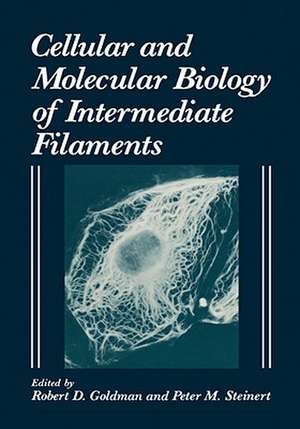Cellular and Molecular Biology of Intermediate Filaments
Editat de R.D. Goldman, P.M. Steinerten Limba Engleză Hardback – 29 apr 1990
| Toate formatele și edițiile | Preț | Express |
|---|---|---|
| Paperback (1) | 1226.70 lei 6-8 săpt. | |
| Springer Us – 4 mai 2013 | 1226.70 lei 6-8 săpt. | |
| Hardback (1) | 1239.99 lei 6-8 săpt. | |
| Springer Us – 29 apr 1990 | 1239.99 lei 6-8 săpt. |
Preț: 1239.99 lei
Preț vechi: 1512.18 lei
-18% Nou
Puncte Express: 1860
Preț estimativ în valută:
237.30€ • 245.15$ • 197.50£
237.30€ • 245.15$ • 197.50£
Carte tipărită la comandă
Livrare economică 26 martie-09 aprilie
Preluare comenzi: 021 569.72.76
Specificații
ISBN-13: 9780306433177
ISBN-10: 0306433176
Pagini: 480
Ilustrații: XX, 480 p.
Dimensiuni: 178 x 254 x 27 mm
Greutate: 1.08 kg
Ediția:1990
Editura: Springer Us
Colecția Springer
Locul publicării:New York, NY, United States
ISBN-10: 0306433176
Pagini: 480
Ilustrații: XX, 480 p.
Dimensiuni: 178 x 254 x 27 mm
Greutate: 1.08 kg
Ediția:1990
Editura: Springer Us
Colecția Springer
Locul publicării:New York, NY, United States
Public țintă
ResearchDescriere
Research activity on intermediate filaments (IF) has increased dramatically over the past decade. For the most part, this surge of interest is due to their identification as ubiquitous constituents of the cytoskeleton and karyoskeleton (nuclear matrix) of eukaryotic cells and the fact that we know very little regarding their functions. In sharp contrast to the other major cytoskeletal systems, microfilaments and microtubules, IF exhibit a high degree of heterogeneity with regard to their protein subunit composition. Indeed, one can only marvel at the number of different IF polypeptides, their associated proteins (IFAP) and, consequently, the number of genes involved in encoding the multiple constituents of the various IF networks found in different cell types. The chapters in this book demonstrate how various experimental approaches involv ing cellular, molecular, biochemical, and immunological methods have been utilized to generate information regarding the structure and function of IF. To this end, we have gathered together chapters from experts in the major fields of IF research. In each chapter, the authors have combined reviews of the available scientific literature with their own ideas on current and future directions for IF research. The chapters have been divided into five major sections which are concerned with the subcellular organization of IF, the molecular structure of IF, the differential expression of IF genes, descriptions of associ ated proteins involved in the intracellular organization of IF, and finally an analysis of the changes seen in IF in pathological conditions.
Cuprins
I. The Subcellular Organization of Intermediate Filaments.- 1. Intermediate Filaments: An Overview.- 2. Intermediate (10-nm) Filaments in Muscle.- 3. Neurofilaments.- 4. The Proteins of Hair and Other Hard ?-Keratins.- 5. The Nuclear Lamina: An Intermediate Filament Protein Structure of the Cell Nucleus.- 6. Interaction of Intermediate Filaments with the Cell Surface.- II. The Structure of Intermediate Filaments.- 7. Primary and Secondary Structure of IF Protein Chains and Modes of Molecular Aggregation.- 8. The Three-Dimensional Structure of IF.- 9. Intermediate Filament Structure: Diversity, Polymorphism, and Analogy to Myosin.- III. Differential Expression of Intermediate Filament Genes.- 10. Hard Keratin IF and Associated Proteins.- 11. Differentiation-Specific Expression of Keratin Pairs.- 12. Keratins and Their Genes in Xenopus laevis: Structural and Developmental Aspects.- 13. Neural Intermediate Filament (Neurofilament) Genes.- 14. The Structure, Complexity, and Evolution of Intermediate Filament Genes.- IV. Accessory Proteins Involved in Regulating the Organization of Intermediate Filaments.- 15. Intermediate Filament-Associated Proteins.- 16. Filaggrins.- V. Pathological Conditions Relating to Intermediate Filaments.- 17. Expression, Organization, and Involvement of Intermediate Filaments in Disease Processes.- 18. The Cytoskeleton in Neurological Disease.








